By Ben Campion
Plaza Fiesta is a large shopping center, but it is also an amazing community space for Latinx people in Atlanta. It is located on Buford Highway, right near the border of Brookhaven and Chamblee. Upon entering, it is immediately clear that the vast majority of the clientele are native Spanish speakers, and I do not know of another similarly large community space in Atlanta where that is the norm. Most people there will speak Spanish with their friends or family who are there with them, the others they pass by (for example, if they accidentally run into someone), and even store employees. What is notable, however, is that the signage there does not have the same overwhelming trend. Though many smaller and/or less permanent signs are very likely to use only Spanish, more of the permanent ones also included English. Some even had English more prominently displayed than they had Spanish. One specific component of Plaza Fiesta where language, both spoken and written, is on display is the food court restaurants. Customers typically read the large, posted menu and then order verbally to an employee. This study examines the presence and prominence of English and Spanish in both written and spoken language at food court restaurants to investigate whether there is a difference in how these languages are used in different contexts within the same setting.
This study focused specifically on food court and/or counter service restaurants. This is because they are very public facing. Their posted menus are visible from far away by large numbers of people, and the interactions between customers and staff can be heard by many people as well. Sometimes that even involves a microphone for the employees to call out order information. Counter service restaurants that had their own space were excluded, as that fact differentiates them from the others in terms of how public their language use is. There were also a few that did not have posted menus, and those were excluded as the study is not feasible without one. Sit-down restaurants were excluded for the same reason. In addition, other types of non-food stores were also not included. The primary reason for that is that the scope of this study extends to the language that surrounds food at Plaza Fiesta. But additionally, the study would not be feasible for those stores since they do not have large, posted signs that summarize their inventory.
The data was collected in a spreadsheet while at the location. All restaurants that met the criteria for inclusion were observed (n = 12). A random order was used, so as to not be overly noticeable moving from one location to the next. First, the menu was observed and photographed. All languages present were identified, recorded, and their relative prominence on the signs were included. Prominence was determined based on two things. First, the size, placement, and other factors that influenced how visible and/or striking the language was. The second was the simple quantity of each language. After that, I approached the counter to observe which languages were being spoken. Once again, the languages were identified, recorded, and their relative prominence was noted. However, this task was more difficult than expected. The data were collected on a Saturday in the early afternoon, which was chosen specifically because there were likely to be many customers. However, it was not taken into account that it was the day before Easter, which added considerably to the number of people present. This made it even more difficult to hear. And because I had to be so close to the counter, I was not able to remain for very long before I would distract the employees. In the future, it would be helpful to find a way to remain longer at each establishment to hear the interactions with more customers. Having another person there with the data collector could help.
The most important finding in this study is that there is indeed a difference in the language use on menus and in speech at Plaza Fiesta food court restaurants. 42% of restaurants had English on their menu. In terms of the primary (more prominent) language, 25% of the menus had English as a primary language (one of those had one section primarily in Spanish and one primarily in English, while the other two had only English as the primary language). But on the other hand, only 17% of the restaurants had Employees speaking English while I was there. None of the restaurants had English as the primary spoken language. Overall, there was not a single restaurant at which Spanish was not both written and spoken.
Table 1
| Restaurant Name | Primary Menu Language | Other Menu Languages | Primary Spoken Language | Other Spoken Languages |
| La Michoacana restaurant | Spanish | Spanish | English | |
| Las recetas y antojitos de la abuela | English and Spanish | Spanish | ||
| Mariscos el malecón express | Spanish | English | Spanish (including in mic) | |
| La costilla grill Mexican restaurant express | Spanish | Spanish (including in mic) | ||
| Yamis pizza Gorditas and wings | Spanish | Spanish | ||
| Yolo rollo ice cream | English | Spanish | Spanish | |
| La guelaguetza | Spanish | Spanish | ||
| No name visible (light blue walls, in back) | Spanish | English | Spanish | |
| Barbacoa mexicana | Spanish | Spanish | ||
| La generala | Spanish | English | Spanish | English |
| Arepa grill | English | Spanish | Spanish | |
| No clear name (near main entrance) | Spanish | Spanish |
In terms of notable qualitative data, the names of dishes almost always came from Spanish. Most were proper nouns, but even for many that were not, they were determined to be Spanish because of the conjunctions and determiners used (see Figure 1). In addition, restaurants in or near the main food court area (which is at the end of the main walkway) were much more likely to have English on their menus (see Figure 2). This makes sense due to the volume of traffic past that area since businesses with more foot traffic might try to appeal to that wider audience. Yolo Rollo Ice Cream, the only dessert-focused shop in this study, used the most English out of all the data (see Figure 3). Their main posted menu was all in English. Only the smaller menus and signs about specials were in Spanish. It is possible that, since rolled ice cream is very well known by a lot of people compared to some of the less common Mexican and Central American dishes at other restaurants, the large-scale use of English could be intended to draw in a broader group of customers.
Figure 1
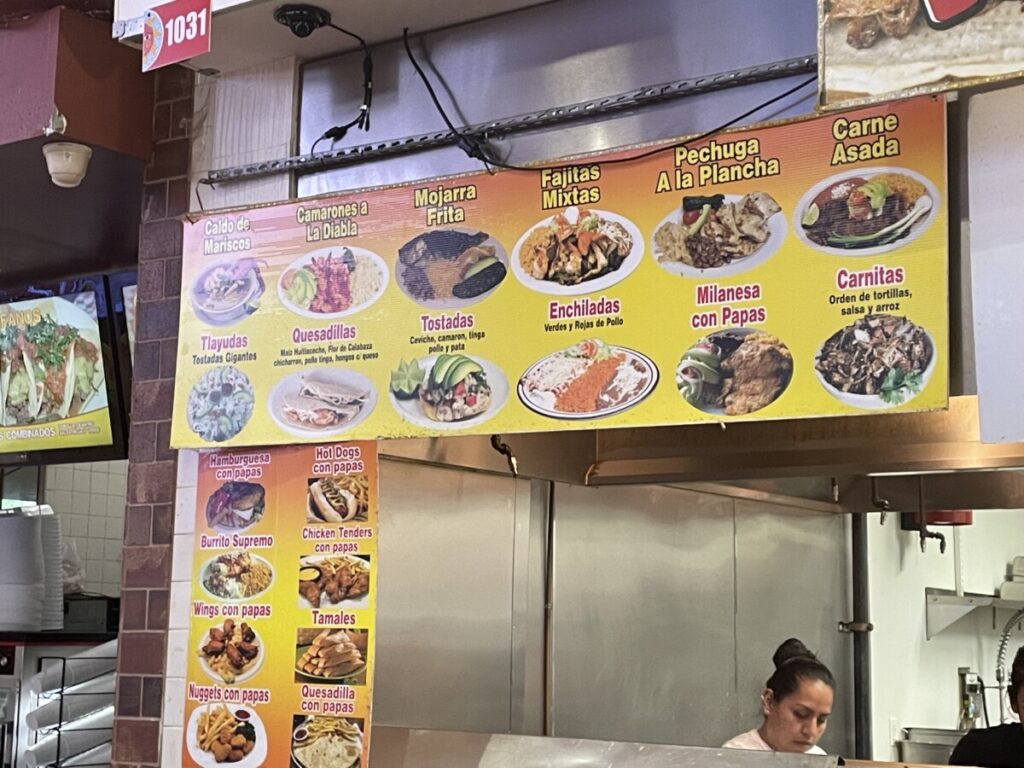
Figure 2
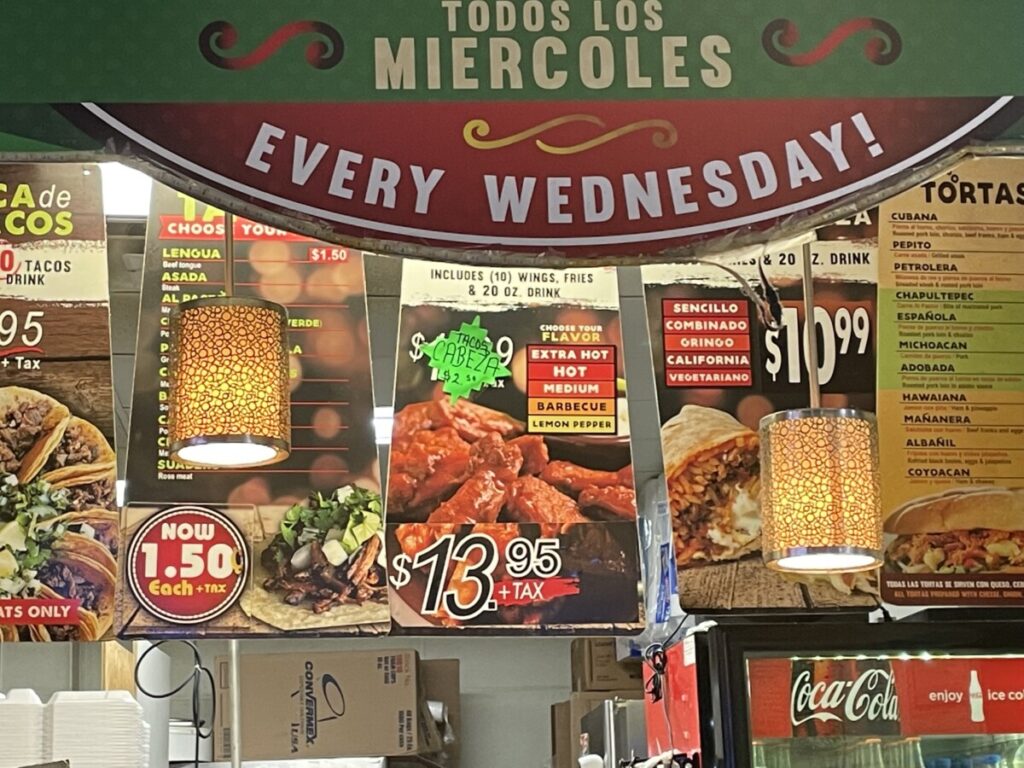
Figure 3
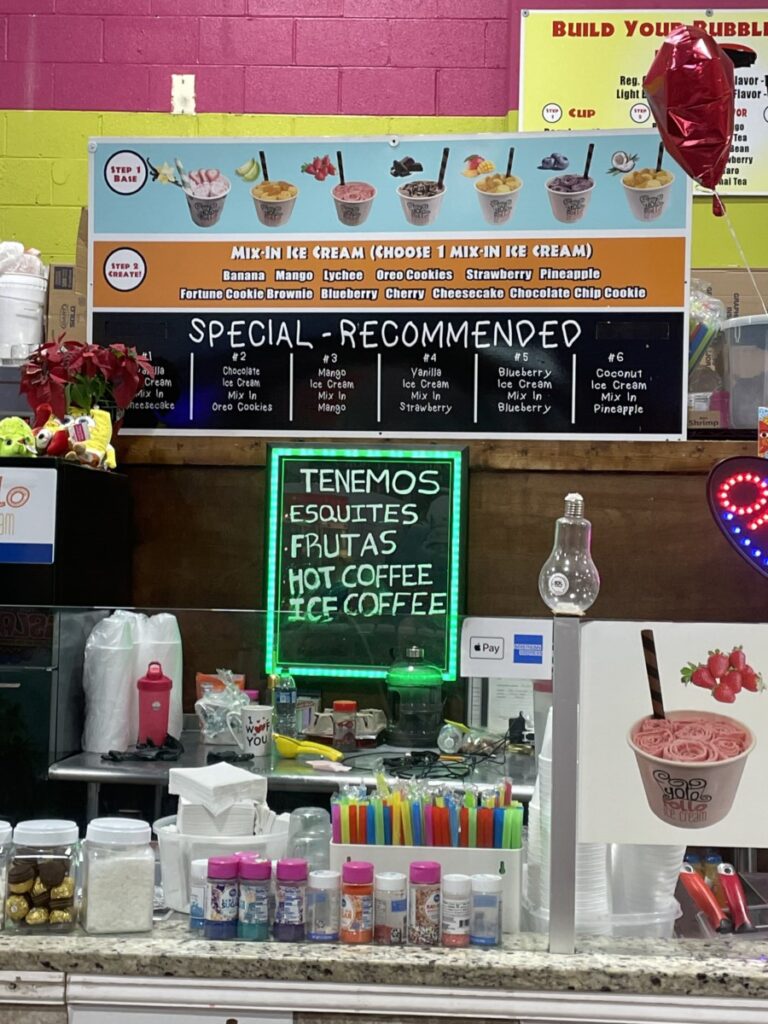
There are a lot of different languages spoken in Metro Atlanta, but multilingualism is often confined to smaller pockets, rather than being observable all over the city. Clarkston and Buford Highway are great examples of this. Both are clusters with extremely high levels of language diversity. But Clarkston is very small, and Buford Highway is very linear. In addition, there are not very many areas where a specific language other than English is very common. Some other cities have a Chinatown or Koreatown or some sort of other area where one language and culture are far more prevalent than anywhere else or any other. In these Atlanta examples, though, many different languages exist right next to each other. In Clarkston, Amharic will be the primary language of one store, while the one next door has most of its signs in Burmese. On Buford Highway, there are numerous shopping plazas that have Cantonese next to Korean next to Spanish. It is an interesting approach to diversity that is not similar to some other parts of the city. Plaza Fiesta, though on Buford Highway, is slightly different, however. It is a community space with many different businesses that use Spanish very prominently. And it would make sense logically that having that community of businesses and patrons that conducts itself in Spanish allows for the findings in this study. For the owner of one of the restaurants there, it makes much more sense to have a menu in Spanish, given that all of the other businesses use Spanish as well, than it would in a place like Asian Square (also on Buford Highway), where Spanish exists but is not very prominent. Overall, Plaza Fiesta is an interesting example of linguistic diversity within greater Atlanta, yet one that is somewhat different from the general trend in the city and along Buford Highway in which different languages can be found side-by-side to each other. For this reason, the findings of this study likely are unique within the city of Atlanta.
In the future, it would be beneficial to alter the methodology of this study to be able to include more speech from the employees. One approach (which would require funding) would be to stand in line and order something, which would allow for more interactions to be heard, as well as standing out less while observing. Bringing another person to stand with the data collector could help as well, as mentioned. One way to expand on this line of inquiry would be to conduct a similar examination of menus and speech in other linguistically diverse places. This would serve to demonstrate whether the findings of a strong preference against English is unique to Plaza Fiesta or whether it exists in other similarly diverse but differently structured business communities.
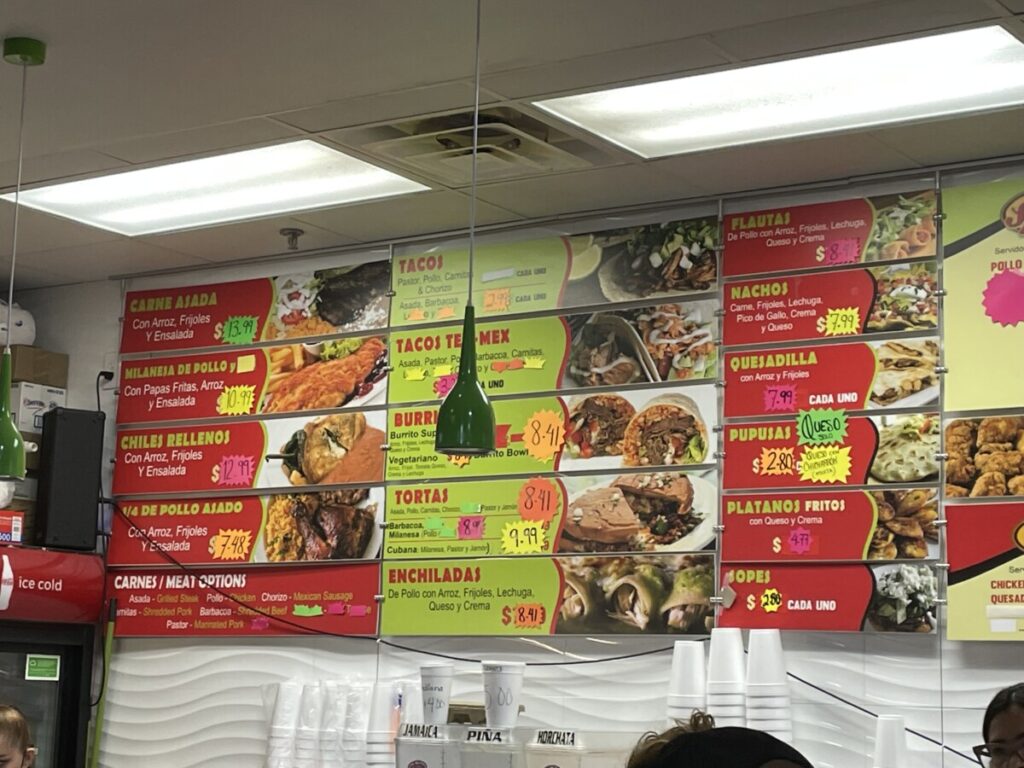
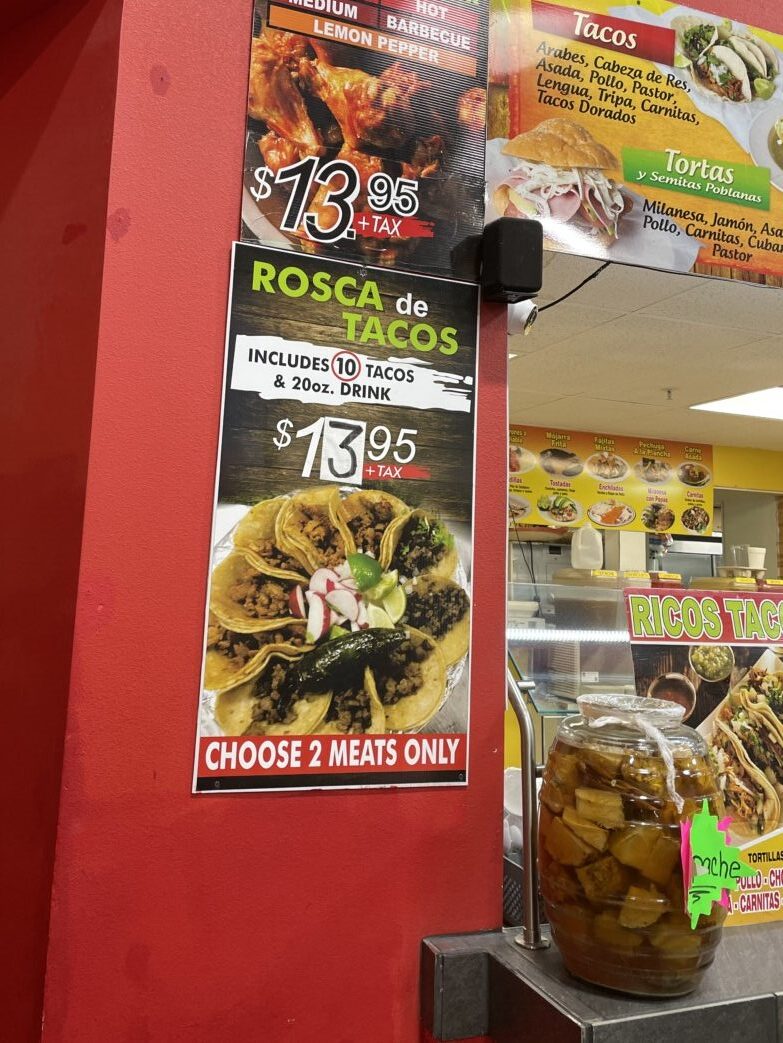

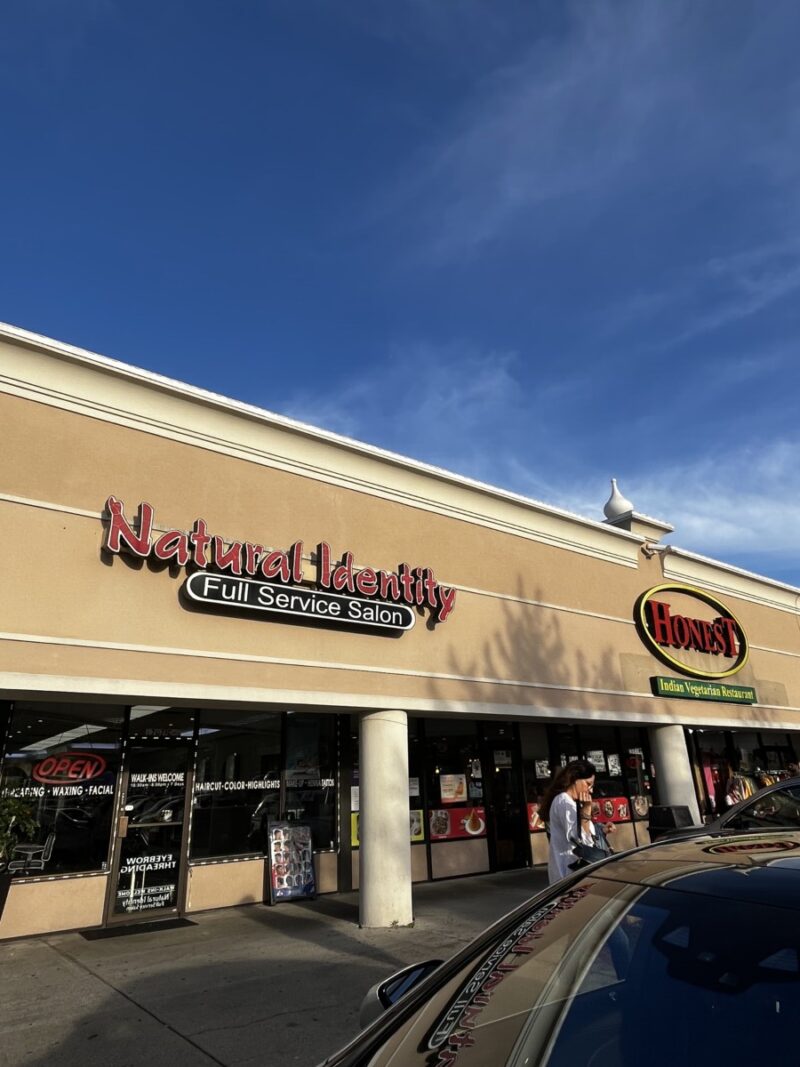


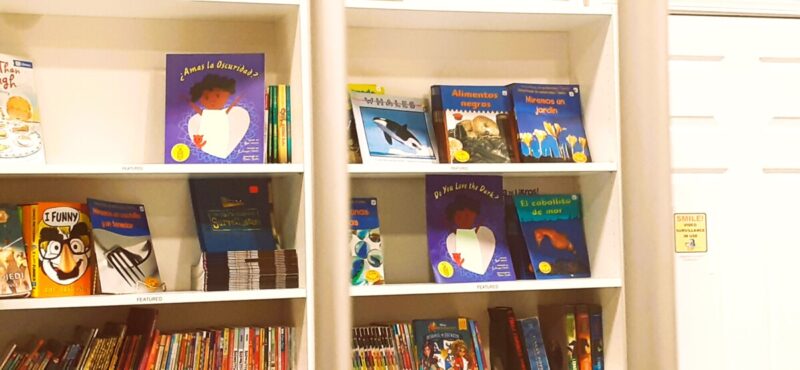
1 Comment
Add Yours →The disparity between the Spanish and English that you heard in comparison to what you observed on the signage is very interesting to me. I am surprised that only 17% of the stores you observed had employees speaking English while you were there. The prominence of English on signage (in relation to speaking) seems to indicate the prestige and prominence of English. Even in an area where it is not the most frequently used language, it makes up nearly 50% of the signage. Even though the US Constitution does not establish an official language, these results provide evidence that English is viewed as the de facto official language even by groups that do not speak it as a first language in America.